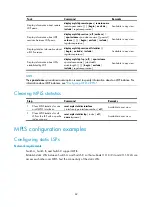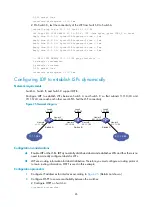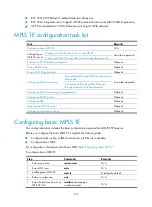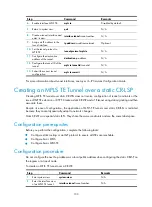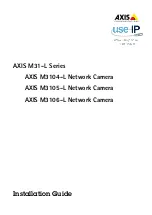
91
Configuring MPLS TE
The S5500-28SC-HI and S5500-52SC-HI switches do not support MPLS TE.
Overview
Network congestion is one of the major problems that can degrade your network backbone
performance. It may occur either when network resources are inadequate or when load distribution is
unbalanced. Traffic engineering (TE) is intended to avoid the latter situation where partial congestion
may occur as the result of inefficient resource allocation.
TE can make the best utilization of network resources and avoid non-even load distribution by real-time
monitoring traffic and traffic load on each network elements to dynamically tune traffic management
attributes, routing parameters and resources constraints.
The performance objectives for TE can be classified as either traffic-oriented or resource-oriented.
•
Traffic–oriented performance objectives enhance Quality of Service (QoS) of traffic streams, such
as minimization of packet loss, minimization of delay, maximization of throughput and enforcement
of service level agreement (SLA).
•
Resource–oriented performance objectives optimize resources utilization. Bandwidth is a crucial
resource on networks. Efficiently managing it is a major task of TE.
To implement TE, you can use interior gateway protocols (IGPs) or Multiprotocol Label Switching (MPLS).
Because IGPs are topology-driven and consider only network connectivity, they fail to present some
dynamic factors such as bandwidth and traffic characteristics.
This IGP disadvantage can be repaired by using an overlay model, such as IP over ATM or IP over FR.
An overlay model provides a virtual topology above the physical network topology for a more scalable
network design. It also provides better traffic and resources control support for implementing a variety of
traffic engineering policies.
Despite all the benefits, overlay models are not suitable for implementing traffic engineering in
large-sized backbones because of their inadequacy in extensibility. In this sense, MPLS TE is a better
traffic engineering solution for its extensibility and ease of implementation.
MPLS is better than IGPs in implementing traffic engineering for the following reasons:
•
MPLS supports explicit LSP routing.
•
LSP routing is easy to manage and maintain compared with traditional packet-by-packet IP
forwarding.
•
MPLS TE uses less system resources compared with other traffic engineering implementations.
MPLS TE combines the MPLS technology and traffic engineering. It delivers the following benefits:
•
Reserve resources by establishing LSP tunnels to specific destinations, allowing traffic to bypass
congested nodes to achieve appropriate load distribution.
•
When network resources are insufficient, MPLS TE allows bandwidth-hungry LSPs or critical user
traffic to occupy the bandwidth for lower priority LSP tunnels.
•
In case an LSP tunnel fails or congestion occurs on a network node, MPLS TE can provide route
backup and Fast Reroute (FRR).






